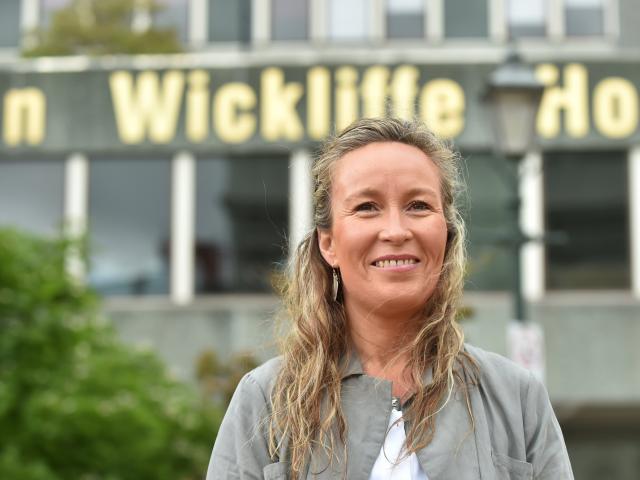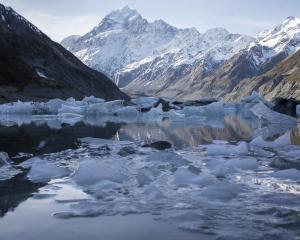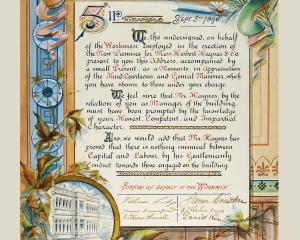
Hundreds of hours have been invested in the public Waitangi Day commemoration at Otakou Marae, on Otago Peninsula. The ethos that motivates this enormous undertaking is an astonishing beacon of hope, writes Bruce Munro.
Perhaps it is this timeless stretch of sand, sea and sky that has gifted the people of Otakou marae a mindset too enlightened by half for these harried and hateful days.
Within sight of the terminus of the winding and picturesque harbourside road — where the tarseal rises from the water’s edge to convey tourists from all nations to the world’s only mainland royal albatross breeding colony — is a slatted wooden boat ramp. Today it lies unused. The only visitor, a velvet-black torea (oystercatcher), swoops in with an affronted screech and walks smartly up and down, hungrily spearing the sand with its bright red needle beak.
It is a still day, warm but overcast. A ceiling of grey cloud hangs low, directing attention horizontally to the encircling green and brown caldera that is the ancient receptacle for the lapping waters of Otago Harbour. On other days, this public boat ramp is a busy portal between land and sea for diverse waterborne ventures.
As such, it is a reminder of Otakou’s distinguished heritage. This strip of land was once the pre-eminent Maori settlement in the region and the early meeting point of locals with Europeans; a special spot where Maori waka and Pakeha boats rocked side by side at their moorings.
Two kilometres south, nestled in the cleavage of age-old hills, but maintaining an expansive view of Otago Harbour, is Otakou marae. On Monday, it will host the official Kai Tahu commemoration of Waitangi Day; a three-yearly right and responsibility shared with the other two Kai Tahu marae where, in 1840, the Treaty of Waitangi was signed. The event attracts government and iwi representatives, as well as growing numbers of the region’s citizenry. In 2014, when it was last held here, 800 people were hosted for the day on the marae.

This year’s visitors will include Kai Tahu patriarch Sir Tipene O’Regan, the Governor-General’s representative Lieutenant Commander Ian Marshall, of the Royal New Zealand Navy, and the Minister for Treaty of Waitangi Negotiations Chris Finlayson. Dignitaries and the public; all will need to be welcomed, shown around, engaged with, provided for and farewelled. It is a costly undertaking, in time, effort and money.
The person charged with making it all happen is Tracey Potiki. She is doing her utmost to ensure the Waitangi Day event "claims its rightful space".
"I think the Treaty of Waitangi has fallen off the radar in terms of policy and such over the past few years," she says.
"People got sick of it. There was a feeling of it being a nuisance instead of a celebration of nationhood.
"I think this year it is about us claiming that celebrational space back, and saying ‘Come on folks, this is something we should all be proud of. This is about our nationhood; this is about our togetherness as Aotearoa’."
Mrs Potiki is of Kai Tahu descent, linked to Otakou through her husband Tuari Potiki. In November, she was given the job of co-ordinating the prestigious celebrations. It meant giving up her summer holiday and taking on an enormous event that had to be rolled out in three months. But she believed her previous experience of project management with kaupapa Maori, Maori ethos, and organisations in Wellington stood her in good stead.
"The biggest challenge is time. There is no doubt about that.
"But none of this stuff scares me. I’m quite fearless actually."
She is supported by a steering committee of six — "[They say] just go and do what you need to do. Complete faith, it’s fantastic." — and hopes to have 40 volunteers taking roles on the day.
"One of the things I love about being Maori is we are forever, forever adaptable. Our rangatira can be out on the paepae [speakers’ bench], like Edward [Ellison] ... and then he can be clearing a drain half an hour later if that’s what needs to happen. So, we have that lovely versatility among ourselves."
Some of the volunteers will be university students; potentially overseas students with limited English and no Te Reo.
"To me, it doesn’t really matter where they’ve come from," Mrs Potiki says.
"If they are willing and have energy, they will enhance what we do, if they come with that intention of helpfulness. That intention crosses over any barriers."
It is an attitude in perfect synchronicity with the theme of this year’s event, te hereka waka.
"Te hereka waka means the mooring place for the many waka who have voyaged to our shores," Mrs Potiki explains.
The day acknowledges a shared maritime history and celebrates the marriages that resulted.
"It is used in its broadest sense as a metaphor that celebrates the arrival of the many people who have landed here."

There will be stories of the taniwha that formed Otago Harbour. Stories of daring, blood and gore. Tales of the whalers who married into Otakou families. And, of the century and a-half wait for land grievances to be taken seriously.
Many of the stories highlight the "dynamic adaptation" that has come with each fresh wave of arrivals.
"It’s important for us to involve our children so that they understand the relevance and importance [of the past]," Ms Tamati-Elliffe says.
In 1840, Kai Tahu chiefs signed the Treaty of Waitangi at Otakou marae, on Otago Peninsula; at Onuku marae, near Akaroa; and Te Rau Aroha marae, at Bluff. From 1844, the iwi sold to the Crown 10 land blocks covering much of the South Island. Reserves of about 3.4 million acres (about 1.4 million ha) were supposed to be set aside for the tribe, but this was never done. Promised hospitals and schools also failed to materialise. Robbed of its economic base, reduced to penury and virtually landless, Kai Tahu made its first land claim in 1849. The Crown did not enter into serious negotiations with the iwi for another 142 years.
That settlement process took a further seven years, coming into effect in 1998.
Although the economic losses to the iwi were valued at more than $20 billion, Kai Tahu agreed to a settlement that included a payout of $170 million: less than 1% of the loss.
"Things have happened historically, but the future is in all our hands," Ms Tamati-Elliffe says.
"Te hereka waka ... can also include everyone who has migrated to this area. Certainly, our door is open to everyone."
On Monday morning, as the hundreds of visitors wait beyond the gates to be called on to the marae, Edward Ellison will be sitting in a place of prominence, on the paepae in front of the meeting house Tamatea.
Women from Otakou will initiate the powhiri (the welcome) with karanga, calling loudly to identify both the manuhiri (the visitors), and the tangata whenua of Otakou.
Once the visitors are seated facing Tamatea, it is the men’s turn. The whaikorero (speeches), acknowledge the visitors, their hosts, the ancestors who have paved the way and the purpose of the gathering, celebrating Waitangi Day as "a foundational part of New Zealand".
The powhiri is an important element of the day, Mr Ellison, who is a kaumatua (elder) of the marae, says.
"It is the encounter process, welcoming manuhiri," Mr Ellison says. "So, we take that very seriously."
He is not being arrogant. The role of spokesman is not one he relishes.
"You are standing there representing the home people, not yourself. It’s important, so there is no backing down. It’s got to be done, so you do it."
Later, Mr Ellison phones back. He had forgotten to mention the final part of the powhiri; kapu ti, morning tea.
"Sharing a cuppa" at the conclusion of the powhiri has more significance than most people would realise, he says.
"It completes the process of making the manuhiri ‘as one with us’."
Mrs Potiki is sitting on a bench seat outside the office of the Otakou runanga, the governing body. From here she can look out over the wharekai (dining hall) and Tamatea to the view of Otakou’s visible trinity of hills, harbour and heavens.
"I hope people will come here and have an experience they remember," she says.
"I hope they feel included and relaxed ... Why is that important? Because we are still having to break down those barriers of ignorance, to this day."
From the minds and mouths of those investing so much to realise this Waitangi Day vision, there have been repeated references to adaptability, hospitality and the Treaty. There is a strong link between the three, Mrs Potiki says.
"Throughout our history we have adapted to many challenges to survive as whanau, hapu and iwi while trying to hold on to the idea that we are part of this nation, even when we are being belittled by this idea that we are poor, dumb, invisible and in need of government handouts."
These people of Otakou have held resolutely to reality.
"We have an openness to work with whatever is happening. I think this attitude is also reflected in how we approach the Treaty."
And, most incredibly, in the face of that often troubled reality, they have not let go of manaakitanga, a spirit of generosity, openness and welcome. In a world increasingly grasping at fascist leaders, travel bans and 15m-high walls to cure its ills, they are a bright pinpoint of light.
"Despite the negative stereotypes we keep going, we keep learning, we keep adapting and forging partnerships ... Aroha ki te tangata, love for people, is what we do."
The commemorations
Te Hereka Waka: Kai Tahu’s public Waitangi Day commemorations, Monday, February 6, at Otakou Marae, Tamatea Rd, Otago Peninsula.
• 9.45am: Visitors assemble at the gate10am: Powhiri/official welcome
• 10.45am: Kapu ti/morning tea
• 11.15am: Guest Speaker Forum, featuring Dave Cull, Hoturoa Kerr, Dilys Johns, Christopher Finlayson and Sir Tipene O’Regan
• 11.15am to 2.15pm: Family Festival, including whare karakia and museum open to public:
Treaty of Waitangi Exhibition
Guide to the waka Workshops
Tamariki/Children’s Zone
• Throughout the day there will be stalls and entertainment, including food stalls. Cash only. People are welcome to bring picnics.
• 3pm to 3.30pm: Poroporoaki/farewell
For more information, visit online at http://ngaitahu.iwi.nz/event/ngai-tahu-treaty-festival-2/












